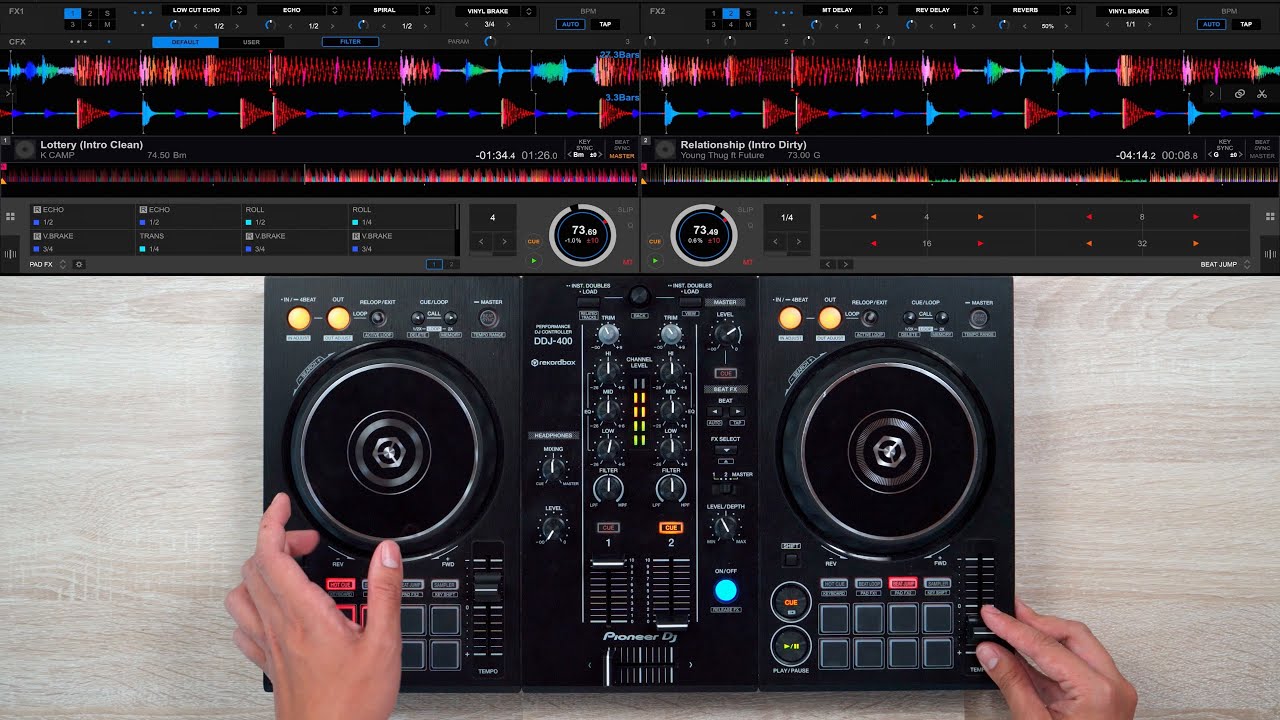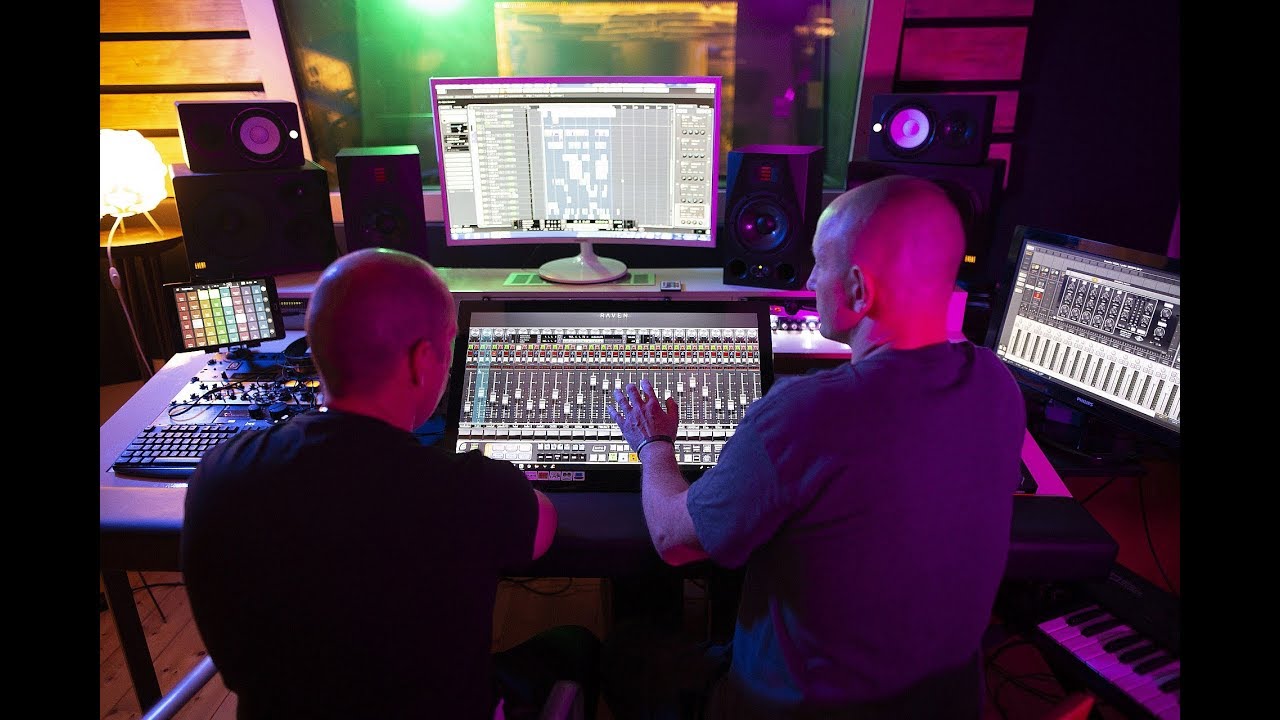Home>Production & Technology>Remix>How To Remix Songs Together


Remix
How To Remix Songs Together
Modified: January 22, 2024
Learn how to remix songs together in just a few easy steps. Create unique and captivating remixes using our proven techniques and unleash your creativity.
(Many of the links in this article redirect to a specific reviewed product. Your purchase of these products through affiliate links helps to generate commission for AudioLover.com, at no extra cost. Learn more)
Table of Contents
Introduction
Remixing songs together is an art form that allows musicians and DJs to create unique and exciting musical compositions. It involves taking elements from different tracks and combining them in innovative ways to produce a fresh and captivating sound. Whether you’re a professional DJ looking to create a killer set or just a music enthusiast eager to experiment, remixing offers endless possibilities for creativity.
In this article, we will explore the process of remixing songs together, from understanding the fundamentals to sharing your finished masterpiece. By following these steps, you will be able to craft your own remixes that stand out and resonate with your audience.
Before we dive into the technical aspects, it’s important to note that remixing requires a solid understanding of music theory, as well as access to the necessary equipment and software. Additionally, it’s essential to respect copyright laws and obtain proper permissions or licenses for the songs you intend to remix.
Now, let’s delve into the exciting world of remixing and discover the steps to create your own unforgettable musical blends.
Understanding Remixing
Remixing is more than just combining songs together; it’s about reinterpreting and transforming the original tracks to create something new and exciting. To effectively remix songs, it’s crucial to understand the key elements and objectives of remixing.
First and foremost, understanding the genre and style of the original tracks is essential. By recognizing the elements that define the genre, such as the rhythm, instrumentation, and overall feel, you can better incorporate these elements into your remix while adding your unique touch.
Another important aspect of remixing is identifying the strengths and weaknesses of the original tracks. By analyzing the elements that make the original songs stand out, you can amplify them in your remix. Additionally, recognizing any areas that could benefit from improvement allows you to enhance the overall quality of your remix.
When remixing songs, it’s essential to strike a balance between staying true to the original tracks and infusing your own creativity. Aim to maintain the essence of the original songs while adding your own personal style, whether it’s through manipulating the arrangement, incorporating new sounds and effects, or adding original elements.
Furthermore, consider the target audience for your remix. Are you remixing a song for the dancefloor or for a chilled-out vibe? Understanding your audience’s preferences will help you make creative decisions that align with their expectations, ensuring your remix resonates with them.
Lastly, it’s vital to remember that remixing is not only about creating something new but also paying homage to the original artists and their work. It’s respectful to credit the original artists and acknowledge their contributions when sharing your remix.
By understanding the fundamentals of remixing, you can approach the process with a clear vision and create remixes that are both innovative and respectful of the original material. So let’s move on to the next step: choosing the songs to remix.
Choosing Songs to Remix
When it comes to remixing songs, one of the first steps is selecting the right tracks to work with. The choice of songs can greatly influence the outcome and overall success of your remix. Here are some considerations to help you choose the perfect songs to remix:
- Familiarity: It’s ideal to select songs that you are already familiar with and enjoy. Having a deep understanding and appreciation for the original tracks will fuel your creativity and help you connect with the music on a deeper level.
- Diversity: Aim to choose songs from different genres or styles to add variety and offer a fresh perspective. Mixing tracks from different musical backgrounds can lead to unique and unexpected remixes.
- Isolation: Look for songs that have clear and distinct elements, such as catchy melodies, memorable vocals, or interesting instrumental sections. These elements can serve as the foundation for your remix and allow you to showcase your creativity in manipulating and rearranging them.
- Audience Appeal: Consider your target audience and their preferences. Choose songs that are popular and well-known within your target demographic. Remixing songs that resonate with your audience increases the likelihood of your remix being well-received.
- Stem Availability: Check if the original tracks have stems available. Stems are individual tracks for different elements of the song, such as vocals, drums, or bass, which allow for more precise and detailed remixing. Having access to stems provides greater flexibility and control over the remixing process.
- Legal Considerations: Ensure that you have the necessary permissions or licenses to remix the songs you choose. Respecting copyright law is crucial to avoid any legal issues. If you’re unsure about the legalities, seek advice or consider remixing songs that are released under a Creative Commons license, which allows for remixing and sharing with proper attribution.
By considering these factors, you can select songs that not only inspire you but also have the potential to create a captivating and engaging remix. Once you have chosen your songs, it’s time to prepare the tracks for the remixing process.
Preparing Your Tracks
Before diving into the remixing process, it’s essential to properly prepare your tracks. This involves organizing and cleaning up the audio files to ensure a smooth and efficient workflow. Here are some crucial steps to prepare your tracks:
- File Organization: Create a dedicated folder for your remix project and organize your tracks within it. Use clear and descriptive file names to easily identify each song and its components. This will help you stay organized and minimize confusion during the remixing process.
- Quality Check: Listen to each track to assess their audio quality. If you notice any issues such as clipping, distortion, or background noise, consider acquiring higher-quality versions of the songs. Remember, the overall quality of the original tracks will significantly influence the final result of your remix.
- Key and BPM Identification: Determine the key and BPM (beats per minute) of each song. This information is crucial for ensuring harmonic compatibility and maintaining a consistent tempo throughout your remix. There are various software and online tools available to help you accurately identify the key and BPM of a track.
- Editing and Trimming: If necessary, perform basic editing and trimming of the tracks before starting the remixing process. Remove any unnecessary sections, such as long intros or outros, to streamline the arrangement and focus on the core elements of the song.
- Backup Your Files: Make regular backups of your tracks to avoid losing your work in case of any technical issues or accidents. Consider using cloud storage or external hard drives to securely store your remix project files.
By taking the time to properly prepare your tracks, you set a strong foundation for the remixing process. Organized files, high-quality audio, and accurate key and BPM information allow for a more streamlined and efficient workflow. With your tracks ready, you can now move on to the next step: syncing and tempo matching.
Syncing and Tempo Matching
Syncing and tempo matching are crucial steps in the remixing process. These techniques ensure that all the tracks in your remix are aligned rhythmically, creating a cohesive and seamless blend. Here’s how you can sync and match the tempo of your tracks:
- Choose a Master Track: Select one track from your remix project as the master track. This will serve as the reference for the tempo and timing of the other tracks.
- Identify the BPM: Determine the BPM of the master track. You can use software or online tools to accurately identify the tempo. Once you have the BPM, set it as the global tempo for your remix project.
- Tempo Match Other Tracks: Align the tempo of the other tracks in your remix to match the BPM of the master track. Some software tools have automatic tempo matching features that can adjust the tempo of the tracks instantly. If not, manually adjust the BPM of each track until they sync up with the master track.
- Sync the Tracks: Once the tempo is matched, sync the tracks together. This involves aligning the beats and bar markers of each track so that they play in harmony. You can use software features like beat grids or quantization to help with this process. Pay attention to any off-beat or irregular sections in the tracks and make adjustments as needed.
- Transition Points: Identify the appropriate points in each track for transitions, such as the start or end of a chorus, verse, or breakdown. These transition points will play a significant role in creating smooth and seamless transitions between tracks in your remix.
Syncing and tempo matching may require careful attention and tweaking, especially when working with tracks of different tempos or time signatures. Take the time to fine-tune the alignment until you achieve a seamless and cohesive rhythm throughout your remix.
Once you have successfully synced and matched the tempo of your tracks, you’re ready to move on to the next step: manipulating song structures.
Manipulating Song Structures
One of the key aspects of remixing is the ability to manipulate the song structures of the original tracks. This allows you to create unique arrangements that stand out and captivate listeners. Here are some techniques to help you effectively manipulate song structures in your remix:
- Introduce Variation: Experiment with reordering the sections of the original tracks. For example, you can start with the chorus, followed by a verse, or create completely new sections. This helps bring a fresh perspective to the song and keeps the listener engaged.
- Looping and Repeating: Take advantage of looping and repeating sections to extend certain parts and emphasize their impact. This technique is commonly used in remixes to create build-ups, drops, or breakdowns that add dynamic elements to the track.
- Chopping and Slicing: Chop and slice different sections of the original tracks to create unique patterns and arrangements. Experiment with rearranging these segments and layering them to build complex and intricate rhythms.
- Adding New Elements: Incorporate new sounds, instruments, or vocal snippets into the remix. These additions can elevate the original tracks and infuse your own creative touch. Be mindful of maintaining a balance between the new elements and the essence of the original songs.
- Modifying Dynamics: Adjust the volume levels, panning, and effects of specific elements within the tracks. This allows you to emphasize certain instruments or vocals, create tension or excitement, and add depth to the remix.
As you manipulate the song structures, keep in mind the overall flow and coherence of your remix. Ensure that transitions between sections are smooth and the remix maintains a cohesive narrative. The goal is to create a remix that retains the essence of the original tracks while offering a fresh and captivating interpretation.
Remember, experimentation is key in remixing. Don’t be afraid to try new techniques and take creative risks. By pushing the boundaries of song structures, you can create remixes that stand out and leave a lasting impression on your audience.
Now that you have a solid grip on manipulating song structures, let’s explore the next step: applying creative effects and transitions.
Creative Effects and Transitions
One of the exciting aspects of remixing is the ability to apply creative effects and transitions. These techniques can elevate your remix, adding depth, excitement, and uniqueness to the overall sound. Here are some creative ideas to explore:
- Filtering and EQ: Use filtering effects like low-pass, high-pass, or band-pass filters to manipulate the frequency range of certain elements. Adjusting the EQ (equalization) settings can enhance or reduce specific frequencies, adding clarity or warmth to the tracks.
- Dynamics and Compression: Apply dynamic processors and compression to control the volume levels and add punch and energy to specific elements within the remix. Compressors help even out the dynamic range, giving your mix more presence and impact.
- Time-based Effects: Experiment with time-based effects like delay, reverb, and echo to create depth and ambiance. These effects can add a sense of space and create interesting textures in your remix.
- Modulation and Pitch Shifting: Modulation effects such as chorus, flanger, and phaser add movement and texture to individual elements or the overall mix. Pitch shifting effects can create unique vocal or instrumental effects, adding an element of surprise to your remix.
- Transitions and Build-ups: Utilize effects like risers, impacts, and white noise sweeps to create smooth and impactful transitions between different sections or tracks. These effects build anticipation and keep the listener engaged throughout the remix.
- Mashup Techniques: Experiment with blending elements from different tracks, creating mashups within your remix. Layering vocals from one track over the instrumental of another, for example, can create exciting and unexpected combinations.
When applying effects and transitions, it’s important to strike a balance. Avoid overusing effects that could overshadow the original tracks or make the remix sound cluttered. Aim for a cohesive and well-balanced mix where the effects enhance the overall sound without overpowering it.
Don’t be afraid to get creative and try new combinations of effects. The goal is to create a remix that surprises and delights the listener, offering a fresh perspective on the original tracks.
Now that we’ve explored creative effects and transitions, let’s move on to the next step: mixing and balancing the elements of your remix.
Mixing and Balancing
Mixing and balancing are crucial steps in the remixing process, ensuring that all the elements in your remix blend together harmoniously and create a cohesive, polished sound. Here are some tips to help you effectively mix and balance your remix:
- Volume Levels: Adjust the volume levels of individual tracks to create a balanced mix. Pay attention to the relative volumes of different elements, such as vocals, drums, and instruments, to ensure that nothing overpowers or gets lost in the mix.
- Panning and Stereo Imaging: Utilize panning techniques to place different elements in the stereo field. This adds depth and width to your remix. Experiment with panning instruments or vocals to create a sense of space and separation.
- Frequency Balance: Ensure that each element in your remix has its own space in the frequency spectrum. Use EQ to carve out space for each component, avoiding frequency clashes and muddiness. Pay attention to the low, mid, and high frequencies, making adjustments as needed.
- Spatial Effects: Add spatial effects like reverb and delay to create a sense of depth and space. These effects can help blend elements together while adding a natural ambiance to the mix. Be mindful of the amount and type of reverb or delay used to maintain clarity.
- Dynamic Processing: Apply dynamic processing techniques like compression and limiting to control the dynamics of individual tracks, ensuring consistent and balanced levels. This helps maintain a cohesive and controlled mix.
- Mixing in Context: Regularly reference your mix in different listening environments (e.g., headphones, speakers, car stereo) to ensure it translates well across different systems. This helps identify any issues in the mix and allows for adjustments to be made accordingly.
Remember, mixing is both an art and a science, and it requires careful attention to detail. Take the time to fine-tune your mix, making small adjustments as needed. Regularly comparing your remix to professional tracks in a similar genre can also provide valuable reference points.
By focusing on achieving a balanced and polished mix, you’ll ensure that every element in your remix shines and contributes to the overall sonic experience. With mixing complete, it’s time to move on to the final step: finalizing your remix.
Finalizing Your Remix
Finalizing your remix involves the last touches and refinements to ensure that your remix is ready for public consumption. This step focuses on fine-tuning the details, making any necessary adjustments, and preparing the remix for distribution. Here’s what you need to consider when finalizing your remix:
- Editing and Arrangement: Review the overall arrangement and structure of your remix. Ensure that the transitions between sections are smooth, the pacing feels right, and the energy builds and releases in a cohesive manner. Make any final edits or adjustments to the arrangement to create a compelling and engaging listening experience.
- Polishing the Mix: Take the time to listen critically to your remix. Pay attention to any remaining EQ imbalances, volume discrepancies, or unwanted artifacts. Make subtle mix adjustments to refine the overall sound and ensure that every element is clear, present, and well-balanced.
- Mastering: Consider mastering your remix to give it a professional and polished sound. Mastering involves enhancing the overall quality, loudness, and clarity of the mix. If you’re not experienced in mastering, consider hiring a professional mastering engineer or using online mastering services to optimize your remix.
- Metadata and File Formats: Add relevant metadata to your finalized remix, including track title, artist name, and any other relevant information. Also, determine the appropriate file formats for distributing your remix. Consider formats like MP3 or WAV, ensuring compatibility with various platforms and devices.
- Artwork and Promotion: Design eye-catching artwork that reflects the vibe and essence of your remix. This will help create visual appeal when sharing your remix online or on social media platforms. Additionally, promote your remix through appropriate channels, such as music blogs, DJ forums, or social media, to gain exposure and reach a wider audience.
Remember, finalizing your remix is a critical step that can greatly impact its reception and success. Take the time to meticulously review and refine your work, paying attention to details that will elevate the listening experience.
With the remix finalized, you’re now ready to share it with the world. Let’s explore how you can effectively share and distribute your remix in the next step.
Sharing Your Remix
Once you’ve finalized your remix, it’s time to share it with the world and showcase your creativity and talent. Here are some effective ways to share and distribute your remix:
- Upload to Music Platforms: Share your remix on popular music platforms such as SoundCloud, YouTube, Bandcamp, or Mixcloud. These platforms allow you to reach a wide audience and engage with fellow music enthusiasts. Make sure to include relevant tags, descriptions, and metadata to improve discoverability.
- Connect with DJs and Producers: Reach out to DJs and producers within your genre and share your remix with them. Building connections in the music community can lead to collaborations, exposure, and potentially getting your remix played at live events or featured in DJ sets and radio shows.
- Create a Remix EP: Consider compiling a collection of your remixes into an EP (extended play) release. This can help you gain more exposure and showcase your skills as a remixer. Release the EP on digital music platforms or consider creating physical copies for promotional purposes.
- Submit to Remix Competitions: Many artists and labels host remix contests, providing an excellent opportunity for exposure. Submit your remix to these competitions and follow the guidelines and deadlines. If your remix stands out, it may receive recognition and potentially lead to future collaborations or releases.
- Share on Social Media: Utilize social media platforms like Instagram, Facebook, Twitter, or TikTok to share teasers, snippets, or full versions of your remix. Leverage relevant hashtags and engage with the community by participating in remix challenges or collaborations.
- Collaborate with Visual Artists: Partnering with visual artists, graphic designers, or video editors can enhance the presentation of your remix. Create visually appealing promotional materials like music videos, lyric videos, or visualizers to accompany your remix and make it more engaging for the audience.
Remember, sharing your remix is just the beginning. Actively engage with your audience, respond to feedback, and foster a supportive community around your work. Collaborate with other artists and continue refining your remixing skills to further grow your presence in the music industry.
Congratulations! You’ve successfully navigated the process of remixing and sharing your creativity with the world. Keep honing your skills, exploring new styles, and pushing the boundaries of your remixing abilities. Enjoy the journey and keep the music flowing!
Conclusion
Remixing songs together is a thrilling and creative process that allows you to transform and reimagine music in unique and exciting ways. Through understanding the fundamentals of remixing, choosing the right songs, preparing the tracks, syncing and tempo matching, manipulating song structures, applying creative effects and transitions, mixing and balancing, finalizing your remix, and sharing it with the world, you have embarked on a journey of artistic expression and musical innovation.
Throughout this article, we have explored the various steps involved in remixing, highlighting the importance of creativity, technical skill, and attention to detail. From selecting the perfect tracks to mastering the art of transitions, each step plays a crucial role in creating remixes that captivate and engage listeners.
Remember that remixing is an ever-evolving art form. As you continue to explore and experiment, trust your instincts, take risks, and develop your own unique style. Stay inspired and open to new ideas, continuously challenging yourself to refine your remixing techniques and broaden your musical horizons.
Whether you’re a professional DJ or simply a music enthusiast, remixing offers a platform for self-expression and artistic growth. Embrace the opportunities to connect with fellow musicians, collaborate, and share your remixes with the world through various digital platforms and social media channels.
As you embark on your remixing journey, remember to respect the original artists and their work. Obtain proper permissions and licenses, give credit where it’s due, and maintain the integrity of the original songs while adding your own personal touch.
So go forth with confidence and creativity, and let your remixes be a reflection of your unique musical voice. Embrace the power of remixing to create exciting and innovative musical compositions that inspire, entertain, and leave a lasting impression on audiences around the world. The remixing world is yours to explore, so let your creativity flow and enjoy the incredible journey ahead!











